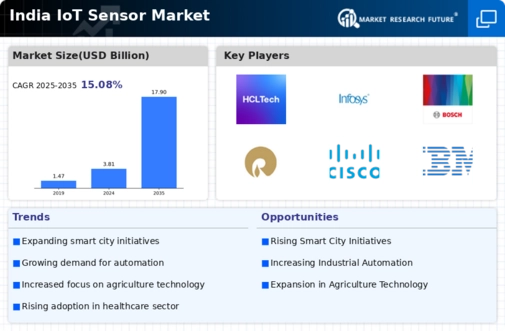Advancements in Industrial IoT
The industrial sector in India is undergoing a transformation with the adoption of Industry 4.0 principles. This shift is significantly impacting the iot sensor market, as manufacturers increasingly rely on sensors for real-time monitoring and predictive maintenance. The market for industrial IoT is anticipated to grow at a CAGR of around 30% from 2023 to 2025. Sensors play a crucial role in optimizing production processes, reducing downtime, and improving safety standards. As industries embrace automation and data-driven decision-making, the demand for advanced sensors is likely to surge, further propelling the iot sensor market.
Rising Demand for Smart Cities
The push towards smart cities in India is a pivotal driver for the iot sensor market. Government initiatives, such as the Smart Cities Mission, aim to enhance urban infrastructure through technology. This initiative is expected to lead to an increase in the deployment of sensors for traffic management, waste management, and energy efficiency. By 2025, the market for smart city solutions is projected to reach approximately $20 billion, with a substantial portion allocated to sensor technologies. The integration of IoT sensors in urban planning not only improves operational efficiency but also enhances the quality of life for residents, thereby driving growth in the iot sensor market.
Expansion of Healthcare Applications
The healthcare sector in India is increasingly leveraging IoT technologies to enhance patient care and operational efficiency. The iot sensor market is experiencing growth due to the rising demand for remote patient monitoring and telemedicine solutions. Sensors are utilized for tracking vital signs, medication adherence, and chronic disease management. The healthcare IoT market is projected to grow at a CAGR of approximately 25% through 2025. This expansion is driven by the need for improved healthcare delivery and the increasing prevalence of chronic diseases. As healthcare providers adopt IoT solutions, the demand for specialized sensors is likely to rise, further stimulating the iot sensor market.
Growing Focus on Environmental Monitoring
Environmental concerns are becoming increasingly prominent in India, leading to a heightened focus on monitoring air and water quality. The iot sensor market is poised to benefit from this trend, as sensors are essential for collecting data on pollutants and environmental conditions. Government regulations and initiatives aimed at improving environmental standards are likely to drive the adoption of IoT sensors in various sectors, including agriculture and urban development. The market for environmental monitoring sensors is expected to grow significantly, potentially reaching $1 billion by 2025. This growth reflects a broader commitment to sustainability and public health, which is integral to the iot sensor market.
Increased Investment in Smart Agriculture
The agricultural sector in India is witnessing a technological revolution, with IoT sensors playing a crucial role in precision farming. Farmers are increasingly adopting sensor technologies to monitor soil moisture, crop health, and weather conditions. This trend is driven by the need to enhance productivity and sustainability in agriculture. The market for smart agriculture solutions is expected to reach $5 billion by 2025, with a significant portion attributed to IoT sensors. As farmers seek to optimize resource usage and improve yields, the iot sensor market is likely to experience substantial growth, reflecting the broader transformation of the agricultural landscape.






















Leave a Comment